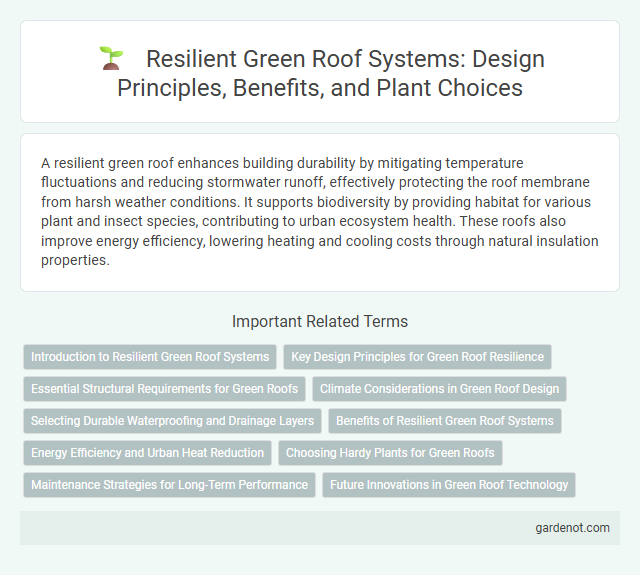A resilient green roof enhances building durability by mitigating temperature fluctuations and reducing stormwater runoff, effectively protecting the roof membrane from harsh weather conditions. It supports biodiversity by providing habitat for various plant and insect species, contributing to urban ecosystem health. These roofs also improve energy efficiency, lowering heating and cooling costs through natural insulation properties.
Introduction to Resilient Green Roof Systems
Resilient green roof systems enhance building durability by integrating vegetation layers that manage stormwater, reduce urban heat island effects, and improve air quality. These systems are engineered with drought-tolerant plants, durable growing mediums, and efficient drainage components to withstand extreme weather conditions. Incorporating resilient green roofs supports sustainable urban infrastructure and promotes long-term environmental benefits.
Key Design Principles for Green Roof Resilience
Key design principles for resilient green roofs emphasize effective stormwater management through layered substrates and drainage systems that promote water retention and reduce runoff. Selecting native, drought-tolerant vegetation enhances ecological stability and minimizes irrigation needs, ensuring plant survival under variable climate conditions. Structural considerations include load capacity and root barriers to maintain building integrity while supporting long-term roof functionality.
Essential Structural Requirements for Green Roofs
Resilient green roofs require robust load-bearing capacity and waterproofing membranes to prevent structural damage and water infiltration. Adequate drainage layers and root barriers are essential to manage excess water and protect roofing materials from root penetration. Incorporating lightweight growing mediums reduces overall weight, ensuring long-term durability and performance of the green roof system.
Climate Considerations in Green Roof Design
Resilient green roofs are engineered to withstand extreme weather conditions by incorporating climate-responsive plant species and advanced waterproofing technologies. Designing green roofs with local climate data ensures optimal vegetation growth, improved thermal regulation, and effective stormwater management. These roofs enhance urban resilience by mitigating heat islands and reducing flood risks through adaptive, climate-smart solutions.
Selecting Durable Waterproofing and Drainage Layers
Selecting durable waterproofing and drainage layers is essential for a resilient green roof to prevent water infiltration and ensure efficient water management. High-quality membranes such as EPDM or TPO provide long-lasting waterproofing performance, while synthetic drainage mats facilitate optimal water flow and root aeration. Proper integration of these layers reduces maintenance needs and extends the overall lifespan of the green roof system.
Benefits of Resilient Green Roof Systems
Resilient green roof systems enhance urban sustainability by improving stormwater management, reducing heat island effects, and increasing energy efficiency through natural insulation. These systems promote biodiversity by providing habitats for various plant and animal species, which supports ecosystem stability. Additionally, resilient green roofs extend roof lifespan by protecting the underlying structure from harsh weather and UV radiation.
Energy Efficiency and Urban Heat Reduction
Resilient green roofs enhance energy efficiency by providing superior insulation, reducing building cooling and heating demands by up to 30%. These living systems mitigate urban heat island effects, lowering surrounding air temperatures by several degrees Celsius through evapotranspiration and shading. Incorporating drought-tolerant plants and water-retentive substrates strengthens resilience against climate extremes, sustaining performance in prolonged heat waves and heavy rainfall events.
Choosing Hardy Plants for Green Roofs
Selecting hardy plants such as sedums, grasses, and succulents ensures the resilience of green roofs by withstanding harsh weather conditions, drought, and temperature fluctuations. These drought-tolerant species require minimal maintenance while enhancing insulation and stormwater management. Using native and adaptive plants strengthens ecological benefits and promotes sustainable green roof performance.
Maintenance Strategies for Long-Term Performance
Resilient green roofs require strategic maintenance to ensure long-term performance, including regular inspection for vegetation health, irrigation system functionality, and drainage efficiency. Implementing seasonal pruning, weed control, and nutrient management helps sustain plant vitality and structural integrity. Monitoring substrate moisture levels and promptly addressing any damage prevents degradation and supports ecosystem resilience.
Future Innovations in Green Roof Technology
Resilient green roofs incorporate advanced materials such as lightweight, water-retentive substrates and drought-resistant plant species to enhance durability and sustainability. Future innovations include the integration of smart irrigation systems powered by IoT sensors that optimize water use based on real-time environmental data. Research also focuses on photovoltaic green roofs combining solar panels with vegetation to maximize energy efficiency and urban heat island mitigation.
Resilient green roof Infographic

 gardenot.com
gardenot.com